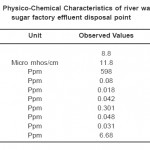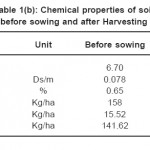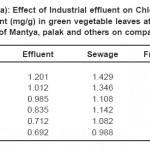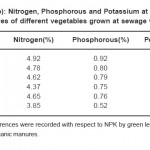Morphological Parameters and Chlorophyll Content of Green Vegetable Plants Available Around Jamkhandi
M.C. Sangannavar1 * and B.M. Kalshetty1
1
Department of Chemistry,
Comm. BHS Arts and TGP Science College,
Jamkhandi,
587 302
India
DOI: http://dx.doi.org/10.12944/CWE.6.1.08
Soil science and plant nutrition due to its potential toxicity to humans and also dependent upon the relative mobility in the soil plant system. The present work includes the study the effect of domestic sewage and industrial effluent on vegetable plant growth and chlorophyll content have been estimated. The effluent is alkaline in nature (pH=9.0), comprises of metals such as Cu, Zn, Ni, Co, Cd, Mn and Cr in trace quantities (< o.1 ppm). The parameter values and chlorophyll content showed in a gradual decline due to effluent concentration. It has been observed that the chlorophyll content at vegetables grown near industrial area. After 20 days there was decline in all the parameters observed. However, at higher concentrations of the effluent, toxic effects were observed from 20th day. The present investigation suggests that the effluent can be used for green vegetable cultivation safely only after proper treatment of effluents.
Copy the following to cite this article:
Sangannavar M.C, Kalshetty B.M. Morphological Parameters and Chlorophyll Content of Green Vegetable Plants Available Around Jamkhandi. Curr World Environ 2011:6(1);67-70. DOI:http://dx.doi.org/10.12944/CWE.6.1.08
Copy the following to cite this URL:
Sangannavar M.C, Kalshetty B.M. Morphological Parameters and Chlorophyll Content of Green Vegetable Plants Available Around Jamkhandi. Curr World Environ 2011:6(1);67-70. Available from: http://www.cwejournal.org/?p=1277
Download article (pdf)
Citation Manager
Publish History
Select type of program for download
| Endnote EndNote format (Mac & Win) | |
| Reference Manager Ris format (Win only) | |
| Procite Ris format (Win only) | |
| Medlars Format | |
| RefWorks Format RefWorks format (Mac & Win) | |
| BibTex Format BibTex format (Mac & Win) |
Article Publishing History
| Received: | 2010-12-09 |
|---|---|
| Accepted: | 2011-01-10 |
Introduction
Water and soil pollution due to the use of waste waters are used for irrigation. Industrialization and urbanization make a cosmopolitan problem, creating adverse effects on soil, crops and vegetable plants when waste (effluent) waters are used for (irrigation) cultivation. In the area of northern part of Karnataka state, especially around Jamkhandi of Bagalkot district, where many sugar industries are installed. The industrial effluents are constantly adding up toxic substances in to the Krishna river water, ground water reservoir at a very high rate, directly or indirectly formers using the river water for green vegetable cultivation, especially in industrial zones. Many regions all over the globe are heavily dependent on ground water for various purposes. Most of the waste water discharged into the surrounding water bodies were found the deteriorates the water quality and disturbed the ecological balance.
However, anthropogenic inputs associated with agricultural practices, industrial processes and solid waste management are important contributors to heavy metal contamination of natural ecosystems.1
The utility of industrial waste water for irrigation of vegetables and other crops in well documented.2 Therefore, the present investigation has been attempted to study the impact of industrial effluent water on vegetable growth, the analyzed parameters compared with the parameters got by fresh water irrigation for vegetable growth.
Material and Methods
An effluent water sample were collected during August 2010 from outlet of sugar factory situated on Krishna river bank, near Jamakhandi (6 Km) in Bagalkot district, Karnataka state. Each effluent sample was collected in well cleaned polythene bottle, the bottle was tightly closed. Immediately pH, EC of the sample were measured in the laboratory and the samples were stored at 4oC for physico-chemical analysis the physico-chemical parameters of water samples from effluent point were analyzed according to standard methods3 and given in table 1A and1B.
Vegetable samples were collected from various spots, where the farmers using such effluent water for irrigation. All the samples were collected in clean polythene bags, made in to three parts, all are dried in oven, shadow, and sun rays. The dried samples (after 10 days) crushed into fine powder, stored in sample tubes well air tight, meanwhile, we collected the vegetable samples from farmers fields were fresh water used for irrigation, those samples brought to the laboratory, dried them as said above and stored in sample tubes.
Both samples (effluent and fresh water use) were analyzed.3 The physico-chemical parameters of effluent water and fresh water are listed in table 2A and 2B. The chlorophyll content estimated following the standard method.4 Using UV Spectrophotometer model ERBA AE-11M with self filters.
Results and Discussion
The physico-chemical parameters of effluent water samples were presented in table 1A and 1B. The sugar factory effluent water contains high EC, Cr, Co, Cd, Mn and Zn values as compared to WHO and ISI standards recommended for disposal of effluent in river water, as well as on land, where the farmers using the land for irrigation / cultivation.
 |
Table 1(a): Physico-Chemical Characteristics of river water near sugar factory effluent disposal point Click here to View table |
 |
Table 1(b): Chemical properties of soil before sowing and after Harvesting Click here to View table |
It was noticed that the maximum growth of vegetable plants were recorded at fresh water irrigation rather than the effluent concentrations. The effluent water and polluted soil decreases in growth of vegetables, this may be due to toxicity of high level of dissolved solids.
The higher concentration of effluent decrease enzyme dehydrogenizes activity that is considered as one of the biochemical change which may have germination and growth.5
The chlorophyll content in vegetable plants presented in table 2A. The chlorophyll content in vegetables at sewage water irrigation recorded more than fresh water irrigation. At effluent concentration there will be decrease in chlorophyll content. The change in chlorophyll concentration indicates that the chlorophyll synthesizing capacity of the vegetables have diminished affecting the photosynthetic process.6, 7 Reported values were fond in the same trends as we were investigated. Also have mentioned the cadmium content in effluent water as reduced plant growth, biomass and leaf figments, and cadmium can harness photosynthetic activity as well as the chlorophyll content.
The vegetables in fresh water irrigation showed growth promotion, overall development of the chlorophyll content. But reduction in vegetable growth at higher concentration of effluent water may be due to higher amount of dissolved solids present in it. The low amount of oxygen in dissolved form due to the presence of higher concentration of solids in the sugar factory industry effluent reduce the energy supply through anaerobic respiration resulting in restriction of the vegetable plants growth.8 The decrease in the chlorophyll content in the vegetable plant grown at effluent water cultivation is due to the inhibitory effect of toxicants of effluent on the chlorophyll synthesis in green vegetable plants. From the findings of the investigated datas is known that the effluents normally highly toxic to the growth as well as they reduce in the chlorophyll content of green vegetables. But it is clearly known the growth and chlorophyll content could be favorable as ground water used for irrigation purpose.
 |
Table 2(a): Effect of Industrial effluent on Chlorophyll content (mg/g) in green vegetable leaves at main crop of Mantya, palak and others on comparison Click here to View table |
 |
Table 2(b): Nitrogen, Phosphorous and Potassium at Harvest by leaves of different vegetables grown at sewage water* Click here to View table |
Toxicity of Metal Ions
Metals like Cu+2, Ni+2, Zn+2, Cd+2, Co+2, Mn+2, Cr+3 are toxic to vegetable at elevated levels. The concentration of Cd+2 in non-polluted soil solution (0.04 - 0.32 mm), if the concentration of Cd exceeds by effluent will cause toxic to most plants.9 The concentration of heavy metals in soil shown two types of causal relationships, on one hand heavy metals complete with essential mineral nutrition for uptake there by disturbing the mineral nutrition of plants10 and on the other hand after uptake by the plant, it accumulates in plant tissues and cells and hampers the general metabolism of the plant.11 The direct and indirect effects on the vegetable growth and physiological functions caused by heavy metal accumulation in vegetables and forming complexes with O, N and S ligands.12 Accumulation of heavy metals decreased the nodulation and also inhibited growth of micro organisms present in the soil (Coppola et, al, 1994).
The total chlorophyll content in leaves of vegetable crops selected for investigation differed significantly due to varying levels of organic manure and inorganic fertilizers. The maximum chlorophyll content recorded in Palak grown sewage water cultivation. Pundi showed least value of chlorophyll content at effluent water cultivation. The increase in chlorophyll content may be due to increased N content in leaf, which is a constituent of chlorophyll.13
The crop growth rate of vegetables varied significantly due to varying doses of organic manures and inorganic fertilizers. The observation are in agreement with the finding of Ram Chandra and Thimmaraju (1983) in Amaranthas. From the observations it revealed that the highest green leaf yield in vegetables were found in sewage water and the application of NPK can be followed for highest green leaf yield in vegetables in the fresh water cultivations.
References
- Pandey, S. Rai, L.C. and Mallick, N., Cynobacterium, Anabaena doiolum, Biometal, 7: 299-304 (1994).
- Javid, S., Singh, S., Ahmed, a Asian Jr. of micro boil, Biotech. Env. Sci. 8(2) 217-222.
- APHA, AWWA, WPCF, Standard methods for the examination of water and waste water, 19th edition, Washington, D.C (1998).
- Pandey, N. and Sharma, P.C., Effect of heavy metals Ca+2, Ni+2 and Cd+2 on growth and Metabolism of Cabbage. Plant Sci. 1163: 753-758 (2002).
- Kumar G.P. and Prasad, M.N., Cd toxicity to ceratophyllum demersum L. Morphological symptoms, membrane damage and ion leakage, Bull. Environ. Contam. Toxical. 72: 1038 -1045 (2004).
- Krupa et al., Pb toxicity: current concerns. Environ. Health. 100: 177-187 (1993).
- Klimentina Demerivaska – Kepova et al.,
- Saxena, D.K., Purification efficiency of Lemna and Azolla for WIMCO effluent. Proc. Nat. Acad. Sci. Ondia. 65(B): I (1995).
- Welch, R.M., Micronutrient Nutrition of plants, crit.Reu. Plant. Sci. 14: 49-82 (1995).
- Lewis, M.A., Use of fresh eater plants for phytotoxicity testing. R.Review Envir. Pollute.87: 319-336 (1995).
- Taylor, G., Extraction of protein from water hyacinth. Hy. Contro J. 8(1): 20-22 (1971).
- Van Assche, F. and Clijsters, H., Effects of metals on enzyme activity in plants, plant. Cell Enviro. 13: 195-206 (1990).
- Padmanabha K. Thesis submitted to the Uni. of Agri. Science B’lore, for Master of Science. 74 (2002).






